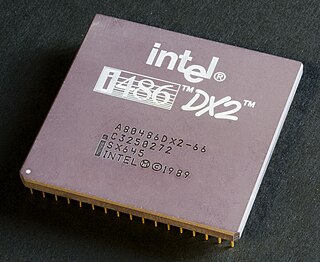Related Research Articles

A central processing unit (CPU)—also called a central processor or main processor—is the most important processor in a given computer. Its electronic circuitry executes instructions of a computer program, such as arithmetic, logic, controlling, and input/output (I/O) operations. This role contrasts with that of external components, such as main memory and I/O circuitry, and specialized coprocessors such as graphics processing units (GPUs).
Processor design is a subfield of computer science and computer engineering (fabrication) that deals with creating a processor, a key component of computer hardware.

An integrated circuit is a set of electronic circuits on one small flat piece of semiconductor material, usually silicon. Large numbers of miniaturized transistors and other electronic components are integrated together on the chip. This results in circuits that are orders of magnitude smaller, faster, and less expensive than those constructed of discrete components, allowing a large transistor count.

The Pentium is a x86 microprocessor introduced by Intel on March 22, 1993. It is the first CPU using the Pentium brand. Considered the fifth generation in the 8086 compatible line of processors, its implementation and microarchitecture was internally called P5.

Moore's law is the observation that the number of transistors in an integrated circuit (IC) doubles about every two years. Moore's law is an observation and projection of a historical trend. Rather than a law of physics, it is an empirical relationship linked to gains from experience in production.

A system on a chip or system-on-chip is an integrated circuit that integrates most or all components of a computer or other electronic system. These components almost always include on-chip central processing unit (CPU), memory interfaces, input/output devices and interfaces, and secondary storage interfaces, often alongside other components such as radio modems and a graphics processing unit (GPU) – all on a single substrate or microchip. SoCs may contain digital and also analog, mixed-signal and often radio frequency signal processing functions.

Pentium 4 is a series of single-core CPUs for desktops, laptops and entry-level servers manufactured by Intel. The processors were shipped from November 20, 2000 until August 8, 2008. It was removed from the official price lists starting in 2010, being replaced by Pentium Dual-Core.
Processor power dissipation or processing unit power dissipation is the process in which computer processors consume electrical energy, and dissipate this energy in the form of heat due to the resistance in the electronic circuits.

In electronics, computer science and computer engineering, microarchitecture, also called computer organization and sometimes abbreviated as µarch or uarch, is the way a given instruction set architecture (ISA) is implemented in a particular processor. A given ISA may be implemented with different microarchitectures; implementations may vary due to different goals of a given design or due to shifts in technology.
The P6 microarchitecture is the sixth-generation Intel x86 microarchitecture, implemented by the Pentium Pro microprocessor that was introduced in November 1995. It is frequently referred to as i686. It was planned to be succeeded by the NetBurst microarchitecture used by the Pentium 4 in 2000, but was revived for the Pentium M line of microprocessors. The successor to the Pentium M variant of the P6 microarchitecture is the Core microarchitecture which in turn is also derived from P6.
The transistor count is the number of transistors in an electronic device. It is the most common measure of integrated circuit complexity. The rate at which MOS transistor counts have increased generally follows Moore's law, which observes that transistor count doubles approximately every two years. However, being directly proportional to the area of a chip, transistor count does not represent how advanced the corresponding manufacturing technology is: a better indication of this is transistor density.
Foxton is an Intel code-name for a power-management technology that was originally planned for inclusion in the first dual-core Itanium 2 processor. By providing very granular control of voltages and clock frequencies within the processor, it enables software performance to be optimized for specific workloads, while ensuring that power consumption remains below a particular value. Due to unspecified issues, Foxton was not included in the initial release of Montecito. According to sources inside Intel, it is under consideration for future Itanium 2 processor versions.

The history of general-purpose CPUs is a continuation of the earlier history of computing hardware.
The AMD Bulldozer Family 15h is a microprocessor microarchitecture for the FX and Opteron line of processors, developed by AMD for the desktop and server markets. Bulldozer is the codename for this family of microarchitectures. It was released on October 12, 2011, as the successor to the K10 microarchitecture.
The term die shrink refers to the scaling of metal–oxide–semiconductor (MOS) devices. The act of shrinking a die creates a somewhat identical circuit using a more advanced fabrication process, usually involving an advance of lithographic nodes. This reduces overall costs for a chip company, as the absence of major architectural changes to the processor lowers research and development costs while at the same time allowing more processor dies to be manufactured on the same piece of silicon wafer, resulting in less cost per product sold.
The SPARC64 V (Zeus) is a SPARC V9 microprocessor designed by Fujitsu. The SPARC64 V was the basis for a series of successive processors designed for servers, and later, supercomputers.

In computer science and computer engineering, computer architecture is a description of the structure of a computer system made from component parts. It can sometimes be a high-level description that ignores details of the implementation. At a more detailed level, the description may include the instruction set architecture design, microarchitecture design, logic design, and implementation.

Ivy Bridge is the codename for Intel's 22 nm microarchitecture used in the third generation of the Intel Core processors. Ivy Bridge is a die shrink to 22 nm process based on FinFET ("3D") Tri-Gate transistors, from the former generation's 32 nm Sandy Bridge microarchitecture—also known as tick–tock model. The name is also applied more broadly to the Xeon and Core i7 Ivy Bridge-E series of processors released in 2013.
In semiconductor electronics, Dennard scaling, also known as MOSFET scaling, is a scaling law which states roughly that, as transistors get smaller, their power density stays constant, so that the power use stays in proportion with area; both voltage and current scale (downward) with length. The law, originally formulated for MOSFETs, is based on a 1974 paper co-authored by Robert H. Dennard, after whom it is named.
Fred Pollack is a retired microprocessor electronics engineer who worked on several Intel chips. He was the lead engineer of the Intel iAPX 432, the lead architect of the Intel i960, and the lead architect of the Pentium Pro.
References
- ↑ Shekhar Borkar, Andrew A. Chien (May 2011). "The Future of Microprocessors". Communications of the ACM. 54 (5): 67–77. doi: 10.1145/1941487.1941507 .[ circular reference ].